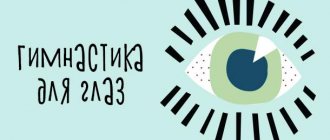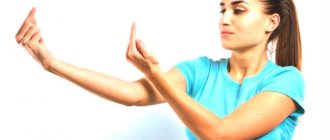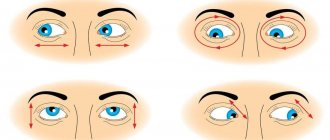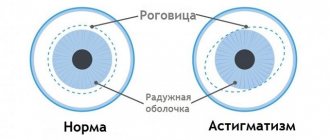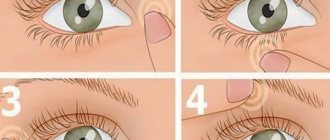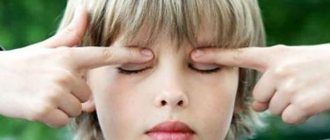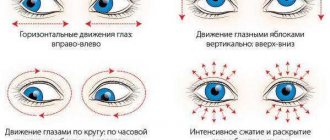How to restore vision with Bates exercises
The complex was developed by an American ophthalmologist. The essence of Bates exercises to improve vision is to relieve excess tension and completely relax the ocular apparatus. The technique includes many exercises designed to affect the eyes.
The following ones stand out:
- Palming. A gymnastic exercise to help relax your eyes. It is performed after warming up. The following actions are performed: close your eyes with your palms, while your hands do not put pressure on them. A person spends 5 minutes in this position. It is advisable to visualize objects from memories. Palming is used at least 3 times a day.
- Drawing with the nose. Drawing will help you relax your head, neck and eyes. Close your eyes and visually draw with your nose. You can draw letters and geometric shapes. The process is performed in a sitting position. Painting with your nose improves blood circulation and relaxes your eyes.
- Look through your fingers. You will need to raise your palms in front of you. Next, open your fingers and look through them, while moving your head from left to right and vice versa. The exercise relieves eye strain. When performing it, the eyes do not concentrate on a specific object.
The listed elements are performed daily. Gymnastics are used with them (looks to the side, rolling the eyes, blinking).
Methods for restoring vision according to Bates
There are two ways to relax the eyes - dynamic and passive. And if the first is characteristic during the period of physical and visual activity, then the second, on the contrary, during the period of rest (relative inactivity of the visual organs). In addition, the recovery method involves not only performing classical exercises, but also some psychological presets. Let's consider each method separately.
Dynamic recovery method
The peculiarity of this method is to increase the motor activity of the eyes with the help of special exercises. Below are instructions with recommendations for their implementation.
Table. Review of effective dynamic exercises.
| Exercise, photo | Description |
| Solarization | The essence of this exercise is to turn your head left and right, but at the same time your eyes remain motionless. There must be a source of light in front of you, be it a ray of sunlight from a window or a lit candle. When you turn your head, you don’t need to look closely at it (source). |
| Frequent blinking | With this forced exercise you can copy the natural process. Blinking frequently can help prevent dry eye surfaces, which office workers often experience. There is no need to squint; blinking lightly and quickly will be enough. |
| Small turns | The body should be motionless, while the head should turn from one side to the other. The purpose of this exercise is to eliminate the desire to peer at the same point. |
| Large body turns | This exercise is based on frequent rotation of the body in different directions. If in the previous exercise you only had to turn your head, then in this exercise the whole body rotates. Make sure that the angle of rotation of the body is 90 degrees. |
| Moving your gaze | Leaving your head motionless, smoothly move your eyes according to a certain trajectory. There are several movement patterns, including clock, diagonal, snake, rectangle and so on. Try to repeat the outlines of all the famous geometric shapes that you know. |
| Central fixation | Another exercise in which you need to fix your gaze on one point. At this point, all other areas that fall into the field of view should be more blurred. The peculiarity of the exercise is the presence of an area in the central region of the retina, called the central recess. It has increased photosensitivity, having a diameter of 0.2 to 0.4 mm. |
On a note! The Bates method requires you to stop wearing glasses, since the lenses do not allow the eye muscles to relax (they are always in a motionless state). But at the same time, tension gradually increases, so you need to try to look so that your eyes do not strain too much.
Bates method
Passive recovery method
Bates created a special set of passive exercises, including:
- mental representation . Its essence is to present an object that you have already seen before. It can be anything, even a white sheet of paper. Try to mentally imagine how you write on this sheet, and put a dot at the end. The point should become the center of your attention;
- palming - This is perhaps the most common exercise used when you feel tired eyes. You can perform this exercise many times throughout the day. To perform it, close your eyes with your palms folded in the shape of a house. Make sure that no light penetrates through your fingers, but that you are comfortable. The eyes themselves also need to be closed. Before starting the procedure, your hands should be warmed up (just rub your palms together);
Palming - memory . This exercise should be performed as a complement to palming. Bates argued that poor vision can only be restored with a completely relaxed psyche. This can be achieved through memories, but they must be pleasant. If possible, think of something green or black, as these colors have a positive effect on the eyes, having a relaxing effect. The main condition for this exercise is positive memories. Only through this attitude can you achieve the desired result.
On a note! Almost all exercises to restore vision include palming. This is not without reason, because only with the help of this procedure can the eye muscles be well relaxed.
Exercises to improve vision
Special diet
In parallel with performing special exercises to improve vision, you must follow a diet. This will improve the effectiveness of treatment. It consists of regularly consuming foods containing vitamins E, C and A. Foods rich in antioxidants actively fight many pathological processes that negatively affect the entire body.
Diet to restore vision
Vitamin A is considered the most beneficial for eye health . It is able to fight diseases such as night blindness or nyctalopia (a disease in which a person has difficulty seeing in the dark). A deficiency of this element in the body can trigger the symptom of dry eye. The most vitamin A is found in peaches, fish, carrots, butter, milk and liver.
Vitamin A content in some foods
The main source of vitamin E is oil, which nutritionists recommend using for preparing various salads. The vitamin is also found in spinach, kale, almonds, dried apricots or even barley. With vitamin C, everything is much more complicated, because it is not able to accumulate in the human body “for a rainy day.” Therefore, you need to take care of the availability of sources of vitamin C. It is found in fruits and vegetables, which must be eaten daily. In winter, when fresh fruit is hard to come by, you can take special vitamin complexes. They already contain all the necessary vitamins and minerals for the body.
What foods contain vitamin E?
Blueberries and blueberries contain many antioxidants that are so beneficial for the eyes. It’s not for nothing that many eye medicines contain extracts of these berries. Proper exercise combined with a special diet will help improve eye health and restore vision. This is the only way you can gain a fresh perspective on the world around you.
Restoring vision
What is the Method based on?
In Russia, the Shichko Bates method was popularized and expanded by ophthalmologist Gennady Shichko, which is why the name Bates-Shichko is often found.
The Russian doctor managed to convey the basic rules, which are:
- effects on the muscles of the organs of vision;
- influence on the human psyche and relief from mental stress;
- relaxation of the entire ocular apparatus.
Bates said that all problems (squint, myopia, farsightedness) are associated with the fact that the human body reacts incorrectly to external influences. Therefore, at a young age, degradation of the visual perception of the world may develop.
The exercises included in the Bates method of restoring vision are aimed at relaxing all parts of the ocular apparatus, as well as changing the reaction to environmental influences. With regular exercise from the complex, you can stop the progression of the disease and even restore vision.
Thus, the Bates-Shichko complex is the only non-drug way to restore the acuity of perception of the world. All actions must be performed under the supervision of a qualified ophthalmologist. Sometimes gymnastics is combined with medication to increase the effectiveness of the entire therapy.
Causes of visual impairment
- 6.1 Video – Vision restoration using the Bates method
William Bates, an American ophthalmologist, conducted many different experiments during his medical practice, during which he was able to find out the reason for the decrease in visual acuity. After this, the doctor began to develop a new method. The main reason is the mental stress that arises when trying to examine an object more clearly .
Bates believed that the main cause of visual impairment is mental stress
As a result, various eye diseases can occur, including:
- astigmatism;
- strabismus;
- age-related decrease in visual acuity;
- farsightedness;
- myopia.
With the development of at least one of these diseases, the patient may experience moral discomfort. This is due to the fact that he can no longer see the bottom lines on the TV monitor, the inscriptions on billboards and everything that he could previously read without any difficulty.
Causes of decreased visual acuity
Strabismus and the Bates Shichko technique
Strabismus can greatly ruin a person’s life, because it impairs visual acuity and is considered a cosmetic defect. Strabismus can be eliminated if the person is not older than 25 years.
One treatment option is regular exercise. They put stress on the weakened eye so that it returns to normal.
It is advisable to begin treatment as soon as the defect is discovered. The Bates technique sometimes becomes the basis of therapy.
During treatment, the following actions are performed:
- Exercise with the sun. You will need to go outside. Afterwards you need to close your eye, with which there are no problems. Next, stand with your back to the sun and begin to turn your body with the side where the squinting eye is located. In this case, actions should be aimed at concentrating and focusing the eye. Perform at least 10 repetitions.
- Actions with a pencil. For this you will need a pencil. You need to raise the pencil to eye level, starting at arm's length and gradually moving closer. When the pencil is 7 cm from the nose, you need to move your gaze along it from top to bottom and from left to right. You should change the focus of your gaze from distant objects to the pencil and vice versa. In healthy people, a pencil located at a distance of 7 cm from the nose will double. In people with severe strabismus, it does not double and remains intact. With regular work with this exercise, it is possible to coordinate the work of the eye muscles, thereby correcting strabismus.
The fight against strabismus continues until the result is obtained. Before using gymnastics, visit a doctor. He will monitor and adjust the treatment. If there is no result, another treatment is prescribed.
https://medglaza.ru/profilaktika/uprazhneniya/metod-bejtsa-vosstanovleniyu.html
Myopia and the fight against it
Myopia is the most common eye disease. It occurs in young and adulthood. More often it affects young people. There are several ways to combat it: conservative treatment and vision correction through surgery. As a method of conservative treatment and correction, the Bates complex can be used.
You will need to perform the following exercises to successfully treat myopia:
- Squint your eyes. If you slowly squint your eyes, you may encounter a moment when they begin to tremble. This happens when they are almost closed. Trembling is an overstrain of the eye muscles, and you need to get rid of it. To do this, concentrate on distant objects. Goal: get rid of trembling while squinting.
- Concentration on two points. For this exercise, you will need to look at the wall and imagine two points with a distance of 0.3-0.5 m from each other. After visualizing the points, imaginary lines are slowly drawn between them. The line is drawn from the top point to the bottom.
- Impact using palming. With this exercise you can combat myopia. Palming allows you to relax between major eye work. It is advisable to complete each set of exercises with its help.
Daily exercises will help get rid of mild myopia. Exercises can be part of a comprehensive treatment and used to prevent vision deterioration.
Eye exercises for farsightedness according to Bates
Ophthalmologist Bates, in order to relax the eyes, strengthen the eye muscles and restore vision, offers a rather unusual set of exercises:
1. Read a book or newspaper with small print every day. The text must be at a distance of 25 cm from the person. Correction tools cannot be used when reading. At the same time, it is also not recommended to strain your eyes too much. This will lead to even more fatigue. When you read, try to look between the lines. This way the eye muscles will not strain too much. This exercise should take no more than 15 minutes. 2. Prepare a Sivtsev table in two formats to test visual acuity. It can be printed on several A4 sheets. One table should be of standard size, like in an ophthalmologist’s office, and the second should be small. Attach a large poster to the wall and move 5 meters away from it. The smaller table needs to be held in your hands. The exercise consists of alternately reading a large and a small table. The gaze, as in the previous task, needs to be directed between the lines. The exercise is performed for 3-5 minutes. 3. For the next task you will again need a large format Sivtsev table. Now you need to alternately look at it and then at other objects located in the room. The ideal way to perform the exercise is to observe moving objects, for example, a bird in a window or a cat in a room.
4. The fourth exercise must be done while standing facing the window. Perform body turns while concentrating on an object outside the window. Movements should be smooth and slow. Place your feet shoulder-width apart and lower your arms along your body. Repeat the turns, always looking forward, for 2-3 minutes.
These exercises may not be suitable for everyone. It can be difficult to read a book without glasses if your refractive error is severe, even for just 15 minutes. Performing eye exercises using the Bates method must be approved by your attending physician.
Advantages and disadvantages of the method
Any method of treating eye diseases has disadvantages and advantages.
The Bates method has the following advantages:
- simplicity;
- accessibility;
- versatility;
- impact on the entire ocular apparatus.
The result with regular use of the technique does appear, but does not always meet people’s expectations, so the following disadvantages stand out:
- low efficiency (compared to surgical treatment methods);
- duration of all procedures (tangible results are obtained after 2-3 months of regular exercises);
- large amounts of time (not all people can spend 30-45 minutes on the complex every day).
The Bates-Shichko method is the only effective method for the conservative treatment of myopia, farsightedness and other eye diseases. There are no side effects when performing gymnastics.
Bates-Shichko therapy is suitable for preventing deterioration of visual acuity. The complex is performed by both children and adults. All actions must be performed under the supervision of a qualified specialist.
Who are the exercises indicated and contraindicated for?
People who have no contraindications and want to correct poor vision can perform the exercises.
Among the indications are:
- myopia;
- farsightedness;
- strabismus.
Regular eye strain during work and study is an indication for using the technique. People using the recovery complex should avoid wearing glasses. Glasses interfere with the whole complex. They do not allow you to train your eye muscles.
Contraindications for training using the Bates-Shichko method are:
- recent eye surgery;
- infectious eye diseases;
- retinal detachment.
If there are contraindications, conservative therapy should not be used. If surgery was performed, you must wait 6 months before using gymnastics. Infectious diseases are also a contraindication.
After treatment, wait 1 month before using a set of physical exercises. Retinal detachment can be aggravated by certain gymnastic exercises.
Are there any contraindications
Despite all the advantages of the technique, it still has several contraindications. First of all, it is not suitable for those patients who have pathologies such as presbyopia, astigmatism, farsightedness and myopia . If you start restoring vision using the Bates method and stop wearing glasses, the results will not take long to arrive.
For exercises using the Bates method, glasses must be removed.
If the above exercises do not help to completely restore visual acuity, then they will at least stop the process of deterioration. It is also not recommended to perform exercises using the Bates method in the postoperative period. Experts recommend abstaining from activities for at least 6 months from the date of surgery. The possibility of retinal detachment is another reason to refrain from performing procedures according to the American doctor’s method.
Contraindications
Combination with other methods of correction and improvement of sharpness
To obtain noticeable results, Bates therapy is combined with other treatment methods. The result depends on the intensity and duration of corrective procedures. The set of exercises combines:
- with the technique of ophthalmologist Zhdanov;
- with the use of medications;
- with hardware treatment.
The essence of combining Zhdanov and Bates is that gymnastics will be performed in the usual mode for a person and at the same time a diary will be kept.
In the diary you will need to indicate your desires and actions taken. Ophthalmologist Zhdanov says that when using a diary, self-hypnosis is carried out (the effectiveness of gymnastics increases), this helps to get a good result.
Zhdanov believes that maintaining a positive mental state is an important part of vision correction. Combining mental and physical influence is the key to restoring a clear perception of the world around us.
The following drugs are used to improve vision:
- Vitafacol drops: improve energy processes and metabolism in the lens of the eye;
- tablets Focus Forte or Blueberry Forte: collection of the most necessary vitamins for vision;
- Quinax drops: protect the eyeball from free radicals and have an antioxidant effect.
The Bates-Shichko method is combined with non-surgical hardware treatment. Magnetic stimulation, electrical stimulation or vacuum massage are used.
The procedures lead to improved metabolic processes, increased resistance to stress and restoration of clarity of vision. Specific actions are selected by the attending physician. Hardware treatment lasts 10-14 days and is carried out 1-2 times a year.
Correcting vision using a combination of the complex and nutrition
Vision correction is complex. It is important to eat properly during Bates therapy.
It is necessary to increase the consumption of the following products:
- blueberry;
- carrot;
- cottage cheese;
- bitter chocolate;
- pumpkin.
Blueberries are an important nutritional element for vision problems. It contains a lot of vitamins that have a beneficial effect on the eye apparatus. Vitamins promote the formation of rhodopsin, which improves retinal sensitivity. Pumpkin and carrots contain vitamin A and beta-carotene.
The influence of these elements on the macula of the ocular apparatus can significantly improve the perception of the world. Cottage cheese contains a large amount of calcium and vitamin B, which is beneficial for the retina.
Dark chocolate reduces the amount of free radicals in the body. Reducing the level of free radicals reduces the likelihood of eye diseases.
You will need to adjust your entire diet by adding the listed products and giving up unhealthy foods.
You will need to exclude:
- roast;
- salty;
- smoked;
- spicy.
You need to eat 4-5 times a day. This diet is maintained throughout the entire vision correction therapy.
Causes
Source: lechim-prosto.ru
Myopic astigmatism, as a rule, is a hereditary pathology. Often observed in children whose parents had vision problems.
Depending on the causes of occurrence, two types of disease are distinguished:
- Acquired astigmatism.
- Congenital or hereditary.
Acquired astigmatism. Occurs as a result of traumatic brain injury or mechanical damage to the eyeball, against the background of ophthalmological diseases, as a complication after surgery or as a result of intoxication of the body.
This is what acquired astigmatism may look like
Congenital or hereditary. Appears due to developmental disorders of the ocular apparatus during embryonic development.
This usually happens if the mother has bad habits, takes illegal drugs during pregnancy, or due to infectious diseases in the early stages.
Important!
During diagnosis, it is important to determine the factor that caused the disease. The overall therapeutic strategy often depends on this.
Congenital myopic astigmatism, which has a high risk of relapse even after the patient’s complete recovery, is the worst to treat.
Feedback on the use of the technique
People who used the Bates-Shichko complex responded more positively. Almost everyone managed to achieve results. Negative reviews are associated with a lack of positive dynamics and wasted time.
It is worth noting that the technique is not able to combat serious visual impairment and eye diseases caused by infections or irreversible processes.
People talk positively about the Bates technique as a preventative measure. Prevention helps prevent dangerous diseases and slow down the process of degradation of the entire ocular apparatus. Strengthening your eyes throughout your life will help you avoid problems in old age.
People who have used eye gymnastics for relaxation respond well. You can restore your eyes after a hard day at work with exercises. It does not take much time to completely restore the eye apparatus from overstrain.
The Bates technique is well suited for preventative action, treatment and maintenance of results. The ophthalmologist will be able to correctly select the load and exercises from the complex.
The effectiveness of the Bates technique
Despite the popularity of the technique, vision restoration using the Bates method cannot boast of great effectiveness since the effectiveness of the exercises is only 50%. In most cases, this type of gymnastics helped only those who experienced vision problems associated with muscle spasms.
But even in such cases, most often a complete cure did not occur, and the patients’ vision improved only within a few diopters.
However, this is a good indicator for a non-surgical method. The main thing when performing such exercises is to adhere to the training schedule and perform eye gymnastics in a lighter version, not only during the correction process, but also after that as a preventive measure.
Exercises
Palming
1.You should look at some letter of a large inscription from a distance. After this, you need to sit down, relax and close your eyes with your hands. Try to remember the letter and its shade. In your thoughts, change its color a little to a blacker one. Open your eyes and look at this letter again. It will seem blacker. Repeat this exercise several times. You will achieve the fact that this letter will stand out more clearly in black and you will quickly snatch it from the image. You will begin to see her better.
2. Before closing your eyes, imagine all the colors in order from lighter to darker. Don't try to keep the shade on for long. A second is enough. The colors should flicker and change quickly. A couple of minutes for this exercise will be enough.
Then try to imagine a piece of white chalk on a black background. The sharp contrast will make it difficult to imagine anything blacker than this background.
Memory
1. Recall a rose in your memories. But you shouldn't try to detail it. Instead, try to imagine an object on it. For example, an ant or some kind of bug. Here it crawls along the stem, quickly moves onto a leaf, and returns back. Now it's already in bud. And in a similar spirit.
You will notice that during the process, although you tried to imagine one object, you did not experience much tension. A moving object was a little distracting and scattered attention, making the memory easy.
For the second part of the exercise you will need Sivtsev’s table
2. Hang Sivtsev’s table with letter symbols at a decent distance, 3-6 meters. Look at a letter and try to imagine it. At the same time, in your imagination, make the black part even blacker, and the light part whiter. In this case, the idea is superimposed on the memory. Open your eyes and look at this letter. After repeating it a couple of times, you will be able to see this letter more clearly. Gradually, you can try to imagine a whole line, or maybe even two.
Solarization
1.Close your eyes and turn your face to the sun. Slowly rotate your head in different directions. Continue for about 5 minutes. Open your eyes for a brief moment, continuing to rotate your head. Don't try to look at the sun, but rather at the area next to it. As you get used to it, you can look closer to the sun.
2. Sit facing the sun. Relax as much as possible. Close your eyes and look towards the sun. Smoothly turn your head from side to side. Under no circumstances should you open your eyes completely. Continue for a couple of minutes.
Moving and swinging
1. Moving your head left and right, turn your gaze in the same direction. A little later, without moving your head, try to look in different directions. You should feel tension in your eye muscles
2.Close your eyes and swing your head like a pendulum. You will be surprised, but your eyeballs will also move in time with your head.
3.Walk with your body swaying. One step and shake your head, your eyes should follow the same movement. Then the next step. And so 15-20 times.
4. Hold the book in front of your eyes and move it. Follow her movement with your eyes.
Blinks and glimpses
1.The exercise should be performed in front of a mirror. Look at your right eye. Blink. Repeat for the other one. 15 times will be enough for each eye.
2. Hang a test card with letters at a distance of 2 meters and try to examine the smallest lines. Look at them for 5-7 minutes. The main condition of the exercise is to blink after reading each letter.
3. When walking, try to blink every time your foot touches the ground. It is recommended to do the exercise for at least 10 minutes.
4. You can arrange a good activity with a ball. You need to quickly, quickly throw it from hand to hand and at the same time blink as soon as the ball flies somewhere.
5. Pick up a book printed in small print. Look only at the white spaces between the lines. Blink at each light stripe. Soon you will notice that the words become clearer and no longer blend together as much. This exercise is an excellent prevention against rapid eye fatigue.
Video: Experience of vision restoration using the Bates method
Do gymnastics 15 minutes a day and your vision will noticeably improve
This eye exercise is very simple and takes minimal time. If you want to achieve results faster, do it several times a day. Even if you have good eyesight, but you begin to notice that your eyes get tired quickly, then do a couple of exercises for prevention. And you will notice how your eyes relax, tension goes away and you begin to feel better.
For people with serious eye diseases, Dr. Bates' method has become a panacea for problems. It helps to completely restore vision and get rid of daily wearing glasses. You will finally get a taste for life.
But it is worth remembering that like any gymnastics, this set of exercises requires time and willpower. You shouldn’t give it up after a couple of weeks, even if you feel an improvement and decide that this is enough for you. You can restore your vision to maximum frequency! The experience of thousands of people who have tried this eye exercise can confirm the effectiveness of the method. And its simplicity is amazing!
What is the connection between vision and muscles
The eye muscles are completely relaxed if everything is fine with vision. Since human eyes have a spherical shape, the image is located correctly on the retina. When viewing objects at close range, the transverse muscles are activated.
At this moment, the longitudinal muscles are at rest. But when a person tries to look at objects that are far from him, the transverse muscles relax.
This discovery led doctors to the conclusion that farsightedness is a consequence of tension in the longitudinal muscles, and myopia - the transverse ones. This is the connection between the eye muscles and vision. This is confirmed by the system of specialists from the USA, according to which strengthening one muscle group provokes relaxation of another.
How to properly perform eye exercises for farsightedness
Before you start performing eye exercises, remove your glasses or contact lenses if you use them. You can perform exercises only if you feel well, do not have elevated temperature or blood pressure, eye diseases or other ailments. You can train your eye muscles with the following exercises:
1. Sit straight on a chair, turn your head and look to the right, then take your starting position. Next, you need to turn your head to the left and look away in the same direction. This task should be completed 10-15 times. 2. Move one hand 30 cm away from your eyes. Hold your gaze for 10 seconds at the tip of your index finger. After this, focus on some object that is located further than your hand. Repeat 10 times. 3. Place your hands behind your head, elbows bent. Bend at the waist, place your feet on your toes. Fix your body in this position for a few seconds, and then relax. Repeat these steps 5-7 times. 4. Extend one hand forward so that the distance between it and your face is 40-50 cm. Next, you should perform clockwise circular movements with your hand, without taking your eyes off your fingers. After that, repeat the same task, but with your other hand raised. The next step involves turning the arm counterclockwise. Training the eye muscles in this way lasts 3-5 minutes.
The final stage will be massaging the neck and back of the head. You need to do eye exercises every day. At the same time, you should not overload yourself. If you feel tired, take a break. All these exercises allow you to relax the muscles of the eyes, as well as the neck and spine. Their advantage is that they take little time. In addition, such exercises have no contraindications and can be performed by everyone even without visiting an ophthalmologist. It is also suitable for people without farsightedness as a way to relieve tension from the eye muscles and take a little break from work.

